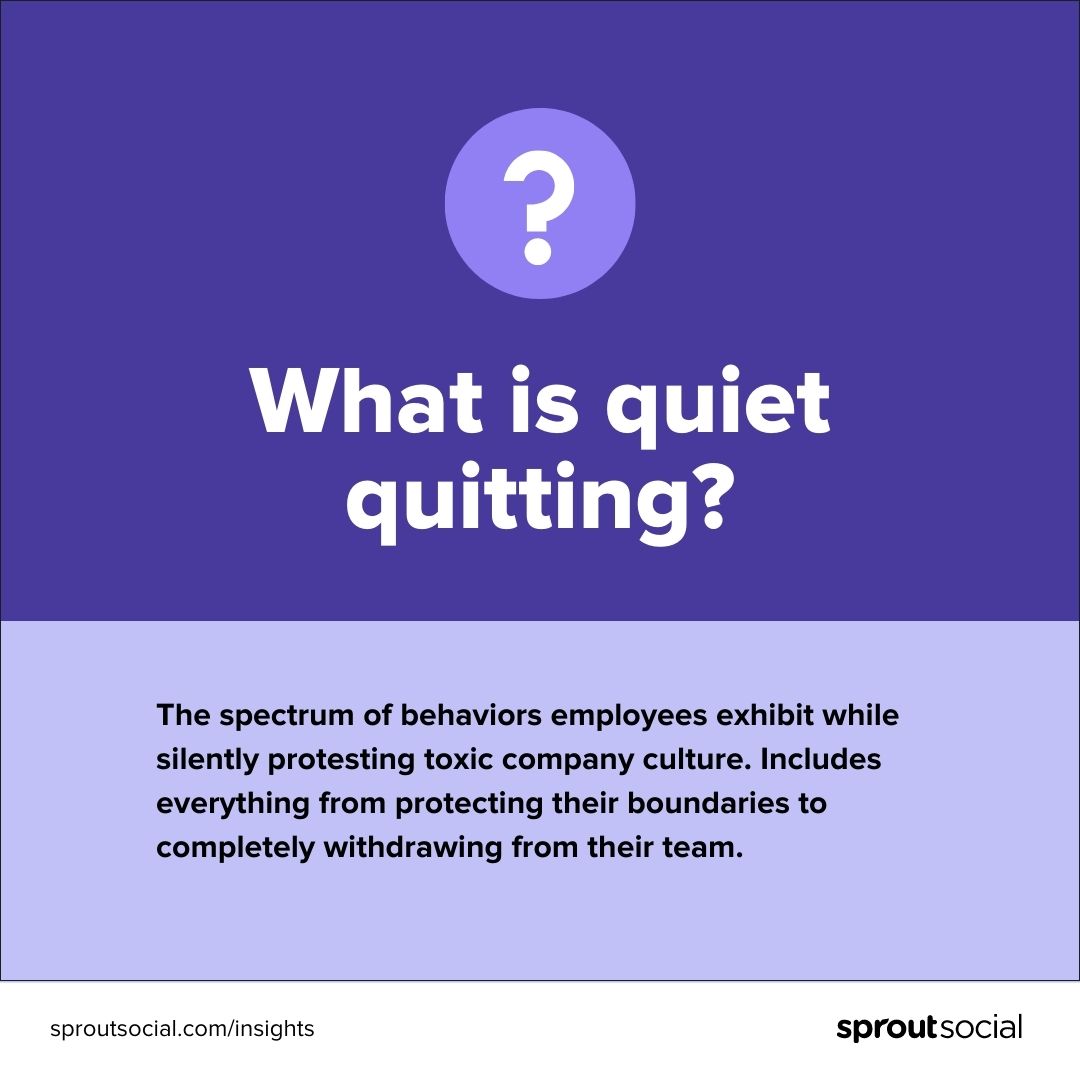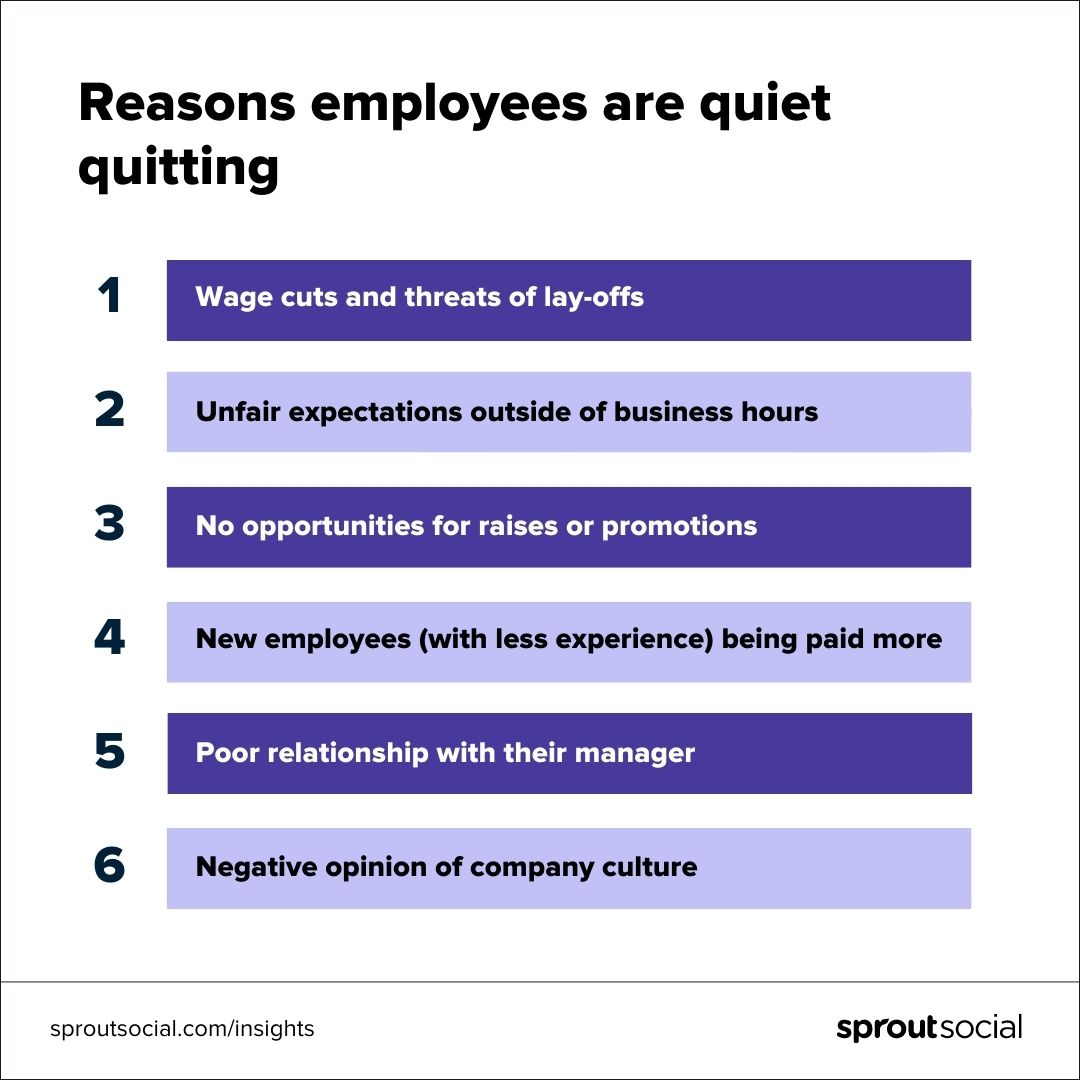Employees are no longer grinding, hustling and girlbossing for companies that don’t value them. Instead, they’re only doing what’s required and reclaiming their lives outside of work.
Where are emboldened, frustrated employees getting inspiration to withdraw? The workplace TikTok trend known as quiet quitting.
@steph.and.den Quiet quitting 🤫 #QuietQuitting #QuietQuittingMyJob #QuietQuittingYourJob #QuittingYourJob #QuitJob #IQuitMyJob #CareerTips #CareerToks #Career #Quitting
♬ Monkeys Spinning Monkeys – Kevin MacLeod & Kevin The Monkey
By quiet quitting work, people are silently protesting toxic company cultures. This isn’t a new phenomenon, but it’s catching fire and might be the reason American productivity is down 4.1% in 2022.
In this article, we’re breaking down quiet quitting—what it is, why it matters and what you should do if you notice your employees getting burnt out.
What is quiet quitting?
Quiet quitting describes the range of behaviors employees exhibit when frustrated with unfair compensation and/or workloads. For some, quiet quitting means putting in 40 hours and clocking out—for others, extreme cynicism and completely withdrawing from their team.

In its early stages, quiet quitting is expressed by an employee saying no to protect their work-life balance and prevent burnout. On TikTok, creators call this, “acting your wage.” For example, employees saying no to working outside of business hours without overtime pay.
As quiet quitting progresses (and ripples across frustrated teams), employees will form cynical opinions of the company. They will stop going the extra mile for raises or promotions that may never come, and their perspective will rub off on team members around them.
@saraisthreads #greenscreen Poor Debrah. #fyp #work #working #corporate #corporatelife #corporatetiktok #corporateamerica #corporatehumor #office #officelife #manager #managersbelike #career
In its final stage, quiet quitting might result in actual quitting, contributing to the historic Great Resignation of the past few years.
Why are employees quiet quitting their job?
According to Sprout Social’s Advanced Social Listening tool, quiet quitting has reached over 2.18 billion impressions on social. From August 17 to August 31, 2022, social volume increased 14,000%.

This meteoric rise comes at a time when employees feel extremely undervalued and underappreciated by their managers. In the wake of wage cuts, lay-offs and new team members (with less experience) being paid more, employees are questioning their loyalty to corporations.
With limited opportunities for raises and promotions, there seems to be no point in working outside of business hours and during PTO. Ultimately, workplace cultures that don’t put people first result in frustration that leads to quiet quitting.

Quiet quitting is a major threat to workplace morale. It signals to all employees—veteran, new and prospective alike—that they won’t be rewarded for overachieving. Many employees are still recovering from pandemic era burnout, so the added pressure of working with colleagues who are quiet quitting can sour already fragile team dynamics, too.
The implications of quiet quitting extend beyond the cultures of individual companies. According to the US Bureau of Labor Statistics, this year’s decrease in American productivity is the largest decline since 1948, when the agency first started keeping track. If this trend continues, quiet quitting could have major impacts on the economy.
What to do if you notice your employees quiet quitting
If your employees start to show signs of quiet quitting, take an honest look at your team’s culture. Do you have fair expectations of your employees? Do your direct reports feel supported?
@barbara.corcoran #QuietQuitting is the boss’s fault.
As businesswoman and TV personality Barbara Corcoran says in this TikTok, “You win people’s loyalty when you show them appreciation and have their interests at heart.”
Here are four steps you can take to reset cultural norms, and prevent and counteract quiet quitting.

1. Foster a team dynamic built on trust, respect and support
As a manager, you set the standard for how your direct reports communicate—with you, each other and the entire company. What you model will become the norm.
If you fall into the blame culture trap, this will set the precedent for your team. Colleagues will take your lead and blame each other instead of working together to find solutions. A strong leader eliminates unhealthy blame and adapts a growth mindset (which influences their team to do the same). By elevating compassion, trust and accountability, you will improve morale, productivity and collaboration.
Prevent quiet quitting by celebrating your team’s wins and learning from your collective failures with equal appreciation.
2. Create a culture of advancement and internal mobility
Quiet quitters report feeling under appreciated by their managers. Ask yourself: when was the last time you gave your team positive feedback?
If you can’t remember a time, make recognition a regular habit moving forward. To get started, consider these questions:
- What is one thing your team accomplished this week? Who contributed to its success?
- Who took the lead on a recent project?
- What is one thing you admire about how someone handled a situation recently?
- How have you seen someone on your team grow professionally?
- Was this a tough week for your team? How did someone overcome the challenges they faced?
Show your team their effort doesn’t go unnoticed. A little recognition can go a long way. Infuse gratitude into your everyday routines like one-on-one meetings, posting in Slack channels and team meetings.

Beyond day-to-day recognition, you should invest in the long-term career success of your direct reports. Give your employees opportunities to upskill and provide them with avenues for advancement, or they might find them elsewhere. Use your organization’s internal recruiting program to help them land new roles and promotions.
According to Jamie Giplin, Sprout Social’s Chief Marketing Officer, “We check in with our people managers regularly to identify rising stars who could fit jobs that we’ve already posted or plan on adding in the future. Keep your people managers in the loop about your roadmap so they’re equipped to identify high-performing team members when it’s time to post that new role.”
3. Encourage your team to take unplugged PTO
Asking employees to work during their PTO or to stay late/come in early (without extra compensation) might not seem like a big deal. You might be short-staffed or in the busy season, and you need extra help.
@johnsfinancetips Quiet quitting #quietquitting #newjob #fintok #moneytok #johnsfiancetips
Yet, not giving your team enough time to recharge can ultimately lead to burnout and quiet quitting—which hurts productivity. Instead, encourage your employees to take breaks and unplugged vacation time. New data demonstrates companies who tried out four-day work weeks have reported increased employee output and a better work-life balance. Give your team the tools to work smarter, not for more hours.
Empathy is your greatest superhero as a leader. Remember your direct reports (and all your colleagues) are people first. Plan on your team needing mental health days, sick days and vacation time. Don’t forget to lead by example and take unplugged days off, too.
4. Proactively give and ask for feedback
Giving feedback can be uncomfortable. By making it a regular ritual with your team, you can make it seem less scary—while nurturing a culture of growth and authenticity.
By proactively giving and asking for feedback regularly, you create a safe space for open communication about bandwidth and culture concerns, common pain points for quiet quitters.
Providing constructive feedback requires honesty, empathy, humility and a learning mindset. Model those traits for your direct reports and avoid giving defensive responses.
@randallupshawlearning #workstress #workanxiety #workboundaries #constructivecriticism #workfeedback #constructivefeedback #leadershiptips #leadershiptiktok #blackwomenatwork #blackwomenoftiktok #womenatwork #wisdom #humility
Remember: above all, your role as a manager is to support and mentor people. Not only will giving and receiving feedback improve your team’s performance, it will also help you better understand how each member of your team works and collaborates differently.
Make your company a great place to work
Quiet quitting is sweeping across workforces, and unfair expectations, limited advancement opportunities and culture concerns are to blame.
As a manager, you can help prevent the phenomenon from taking hold at your company by trusting your team, helping them grow their careers, championing PTO and opening up lines of honest communication.
Want to learn more tips to uplevel your people management skills? Learn how to have effective conversations with your team about burnout.
The post What is quiet quitting and what managers should know appeared first on Sprout Social.
from Sprout Social https://ift.tt/DgAkzj1
via IFTTT

No comments:
Post a Comment